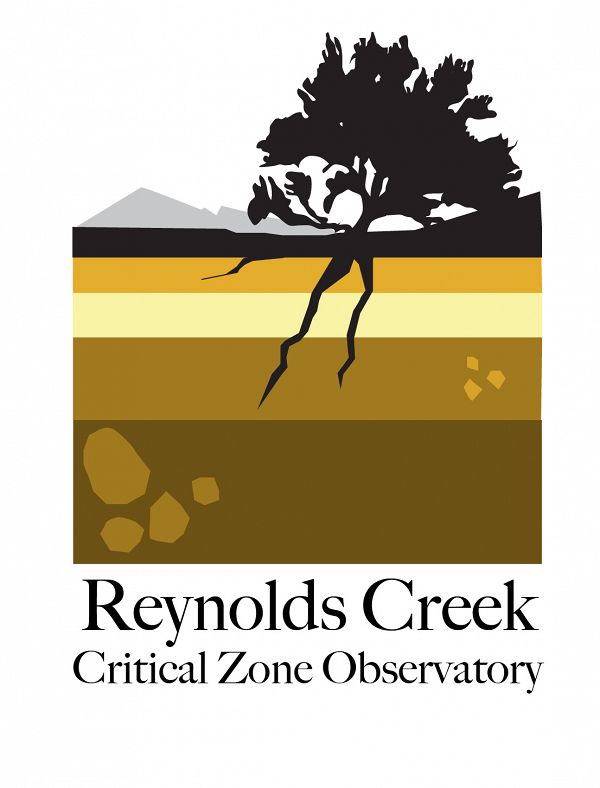Summary & Purpose
Mountainous terrain defines many dryland regions and results in pronounced variation in soil thickness and soil organic carbon (SOC) stocks that is not currently captured by carbon and global climate models. Here we quantify how total profile SOC varies with topographic morphometry, aspect and curvature, to estimate SOC storage within a 1.8 km2 granite-dominated catchment in Idaho, U.S.A. We show that north-facing soil pits have on average 2.9 times more total SOC per area than the south-facing sites, and convergent soil pits have on average 6.4 times more total SOC per area compared to divergent sites. Curvature explained 91% of variation in total profile SOC at a 3-m resolution when the entire vertical dimension of SOC was determined. Catchment SOC stocks were determined from this curvature-SOC model and showed that SOC below 0.3 m depth accounted for >50% of the catchment total SOC, indicating substantial underestimation of SOC stocks if only sampled at shallower depths. We conclude that processes responsible for carbon sequestration in soils vary spatially at relatively small scales, and they can be described in a deterministic fashion given adequate elevation data.
Date of Publication or Submission
1-10-2018
DOI
https://doi.org/10.18122/B2XT55
Funding Citation
This study was conducted in collaboration and cooperation with the USDA Agriculture Research Service, Northwest Watershed Research Center, Boise, Idaho, and landowners within the Reynolds Creek Critical Zone Observatory (RC CZO). Support for this research was provided by NSF for RC CZO Cooperative agreement NSF EAR-1331872 (Kathleen Lohse, Principal Investigator; Nancy Glenn, Co-Principal Investigator; Alejandro Flores, Co-Principal Investigator; Shawn Benner, Co-Principal Investigator; Mark Seyfried, Co-Principal Investigator). Data are available at the criticalzone.org data portal. Every sample at RC CZO is registered with an International Geo Sample Number through System for Earth Sample Registration (SESAR). Gordon Gulch data collection was funded by the Keck Geology Consortium, the National Science Foundation (NSF EAR-1062720), University of Connecticut Research Foundation, and NSF Boulder Creek Critical Zone Observatory (NSF EAR-072496). The authors declare no financial conflicts.
Single Dataset or Series?
Single Dataset
Data Format
.jpg, .mpk, .xlsc
Time Period
June 2010-June 2015
Privacy and Confidentiality Statement
Boise State is explicitly compliant with federal and state laws surrounding data privacy including the protection of personal financial information through the Gramm-Leach-Bliley Act, personal medical information through HIPAA, HITECH and other regulations. All human subject data (e.g., surveys) has been collected and managed only by personnel with adequate human subject protection certification.
Use Restrictions
1. Use our data freely. Critical Zone Observatory Data Products are released to the public and may be freely copied, distributed, edited, remixed, and built upon under the condition that you give acknowledgment as described below.
2. Give proper acknowledgment. Publications, models and data products that make use of these datasets must include proper acknowledgement, including citing datasets in a similar way to citing a journal article (i.e. author, title, year of publication, edition or version, and URL or DOI access information. See http://www.datacite.org/whycitedata).
3. Let us know how you will use the data. The dataset creators would appreciate hearing of any plans to use the dataset. Consider consultation or collaboration with dataset creators.
Disclaimer of Warranty
BOISE STATE UNIVERSITY MAKES NO REPRESENTATIONS ABOUT THE SUITABILITY OF THE INFORMATION CONTAINED IN OR PROVIDED AS PART OF THE SYSTEM FOR ANY PURPOSE. ALL SUCH INFORMATION IS PROVIDED "AS IS" WITHOUT WARRANTY OF ANY KIND. BOISE STATE UNIVERSITY HEREBY DISCLAIMS ALL WARRANTIES AND CONDITIONS WITH REGARD TO THIS INFORMATION, INCLUDING ALL WARRANTIES AND CONDITIONS OF MERCHANTABILITY, WHETHER EXPRESS, IMPLIED OR STATUTORY, FITNESS FOR A PARTICULAR PURPOSE, TITLE AND NON-INFRINGEMENT. IN NO EVENT SHALL BOISE STATE UNIVERSITY BE LIABLE FOR ANY SPECIAL, INDIRECT OR CONSEQUENTIAL DAMAGES OR ANY DAMAGES WHATSOEVER RESULTING FROM LOSS OF USE, DATA OR PROFITS, WHETHER IN AN ACTION OF CONTRACT, NEGLIGENCE OR OTHER TORTIOUS ACTION, ARISING OUT OF OR IN CONNECTION WITH THE USE OR PERFORMANCE OF INFORMATION AVAILABLE FROM THE SYSTEM. THE INFORMATION PROVIDED BY THE SYSTEM COULD INCLUDE TECHNICAL INACCURACIES OR TYPOGRAPHICAL ERRORS. CHANGES ARE PERIODICALLY ADDED TO THE INFORMATION HEREIN. COMPANY AND/OR ITS RESPECTIVE SUPPLIERS MAY MAKE IMPROVEMENTS AND/OR CHANGES IN THE PRODUCT(S) AND/OR THE PROGRAM(S) DESCRIBED HEREIN AT ANY TIME, WITH OR WITHOUT NOTICE TO YOU. BOISE STATE UNIVERSITY DOES NOT MAKE ANY ASSURANCES WITH REGARD TO THE ACCURACY OF THE RESULTS OR OUTPUT THAT DERIVES FROM USE OF THE SYSTEM.
Recommended Citation
Patton, Nicholas R.; Lohse, Kathleen A.; Godsey, Sarah E.; Parsons, Susan B.; and Seyfried, Mark S.. (2018). Topographic Controls of Soil Organic Carbon on Soil-Mantled Landscapes [Data set]. Retrieved from https://doi.org/10.18122/B2XT55


Comments
Erratum 4/4/2019: Original title to this data set was "Dataset for Topographic Controls on Total Soil Organic Carbon in Semi-Arid Environments"
Erratum 4/18/2019: The original files were modified to reflect the new direction of the paper. In particular, we removed the negative curvature convention from all curvature values and we utilised a linear regression model. The modifications to our model, though minor, did change the values of our predicted raster layers and model outputs.
Erratum 7/15/2019: Patton_DOI_Carbon_Paper_03072019.xls is an updated file. Items highlighted in yellow indicate changes since previous update.
Curvature is the rate of change in slope from a fixed point on a landscape in all directions, and is extremely sensitive to any changes in elevation, procedures, or processing. These data have been amended to include additional metadata descriptions of how curvature was calculated for this dataset. Multiple sets of curvature values calculated at different spatial resolutions have been included, and a column for the name of the catchment used to derive statistics from has been added. Reported curvature values have been re-calculated to remove the negative curvature convention.